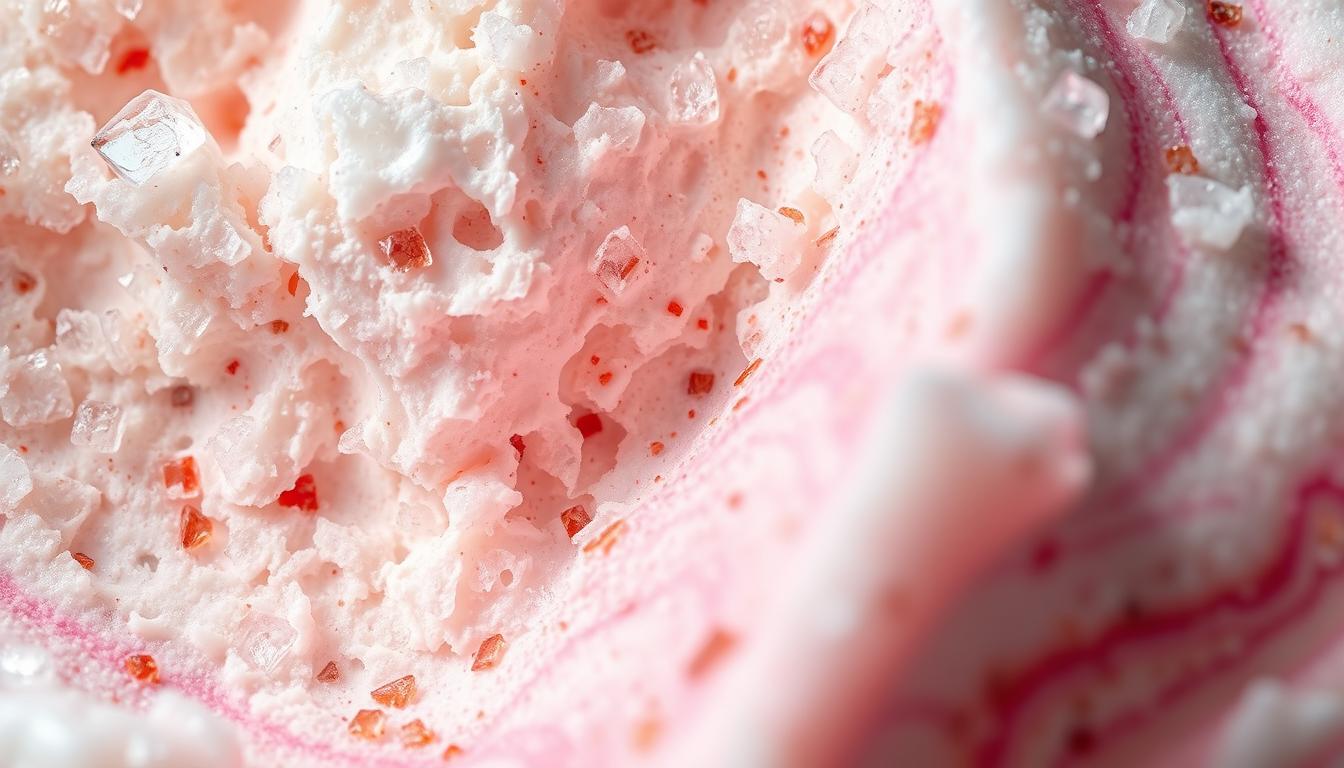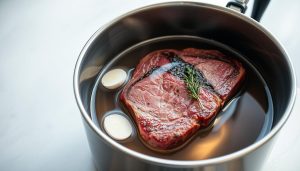Imagine your premium dessert transforming into a gritty mess before reaching your spoon. Research shows ice crystals in frozen treats can grow 150% larger within a year of storage at typical freezer temperatures. This invisible transformation turns velvety textures into sandy disappointments that cost manufacturers millions annually.
What starts as microscopic structures evolves into visible flaws through temperature shifts and improper handling. The difference between a satisfying scoop and an icy letdown lies in crystal sizes smaller than a human hair’s width. When these particles exceed 55 micrometers, they create unpleasant mouthfeel that consumers instantly reject.
Advanced freezing techniques and ingredient balances help maintain ideal consistency. But even minor storage errors accelerate structural breakdown, permanently altering how flavors release during consumption. This delicate dance between physics and culinary art determines whether your dessert experience feels luxurious or lackluster.
Key Takeaways
- Crystal size directly impacts perceived quality, with smaller particles creating smoother sensations
- Temperature stability prevents damaging growth during storage and transportation
- Optimal freezing processes preserve structural integrity from production to consumption
- Texture degradation affects flavor release and overall enjoyment
- Industry professionals use precise formulations to combat natural crystallization
Understanding Ice Cream Crystals and Their Formation
Premium frozen treats achieve their signature smoothness through precise molecular engineering. Three key factors control crystalline development: chilling rates, ingredient interactions, and environmental conditions during preservation.

The Science Behind Solid-State Transformation
Water molecules organize into hexagonal patterns during freezing – a process called nucleation. Rapid chilling at -35°C creates numerous tiny nuclei, while slower cooling enables fewer, larger structures. Commercial operations use specialized equipment to flash-freeze mixtures within minutes, locking in microcrystalline perfection.
Environmental Influencers Matter
Three elements dictate crystalline quality:
- Thermal stability: Fluctuations above -18°C reactivate molecular movement
- Aeration levels: Proper overrun (air incorporation) creates insulating pockets
- Binding agents: Guar gum and carrageenan restrict water mobility
Emulsifiers perform dual functions by stabilizing fat droplets and modifying crystal growth patterns. As one food technologist notes: “The difference between velvety and grainy lies in controlling water’s dance during phase changes.” Modern stabilizer blends can reduce crystal size by 40% compared to traditional recipes.
Impact on Ice Cream Texture and Quality
That first spoonful tells you everything. Premium frozen desserts rely on precise ratios – over 12% milk fat and 60-90% air incorporation – to create their signature richness. When crystal structures exceed critical thresholds, these carefully engineered ratios collapse like a failed soufflé.
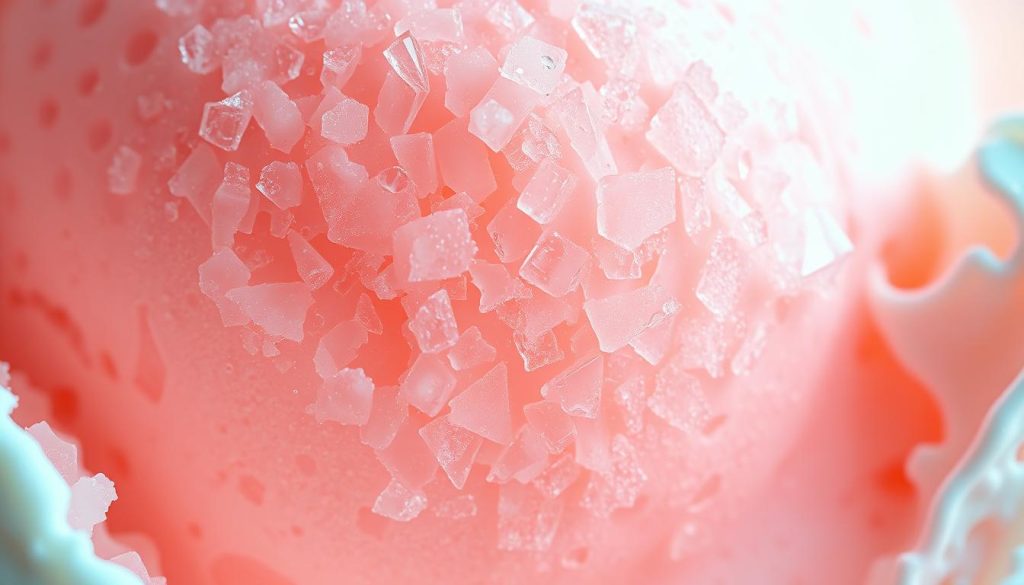
Effects on Smoothness and Creaminess
Your tongue detects particles as small as 55 micrometers. Beyond this limit, what should feel velvety becomes gritty. Large crystals act like sandpaper, tearing through the delicate emulsion of fat globules and air pockets that define premium products. This structural damage explains why high-end manufacturers obsess over rapid freezing methods that lock in microscopic crystals.
Sensory and Flavor Implications
Texture breakdown doesn’t just feel wrong – it tastes wrong. Rough surfaces release flavor compounds unevenly, muting subtle notes like vanilla bean or sea salt caramel. As one food scientist explains: “Smooth textures act like flavor amplifiers. Damage that surface, and you’re eating through static.” Properly maintained structures melt at the ideal rate, letting flavors unfold in harmonious layers rather than watery puddles.
You’ll recognize quality products by their resistance to temperature swings. Those maintaining under 55-micrometer crystals preserve both mouthfeel and taste integrity, proving why artisanal brands invest in industrial-grade freezers and stabilizer blends. The difference shows in every luxurious bite.
Storage Conditions and Ice Crystal Growth
Proper storage isn’t just about keeping desserts cold—it’s a science that determines whether your treat stays velvety or turns gritty. Studies reveal frozen products stored at -18°C develop crystals 2.5 times larger within a year compared to those kept at -50°C. This hidden transformation happens silently but impacts every bite.
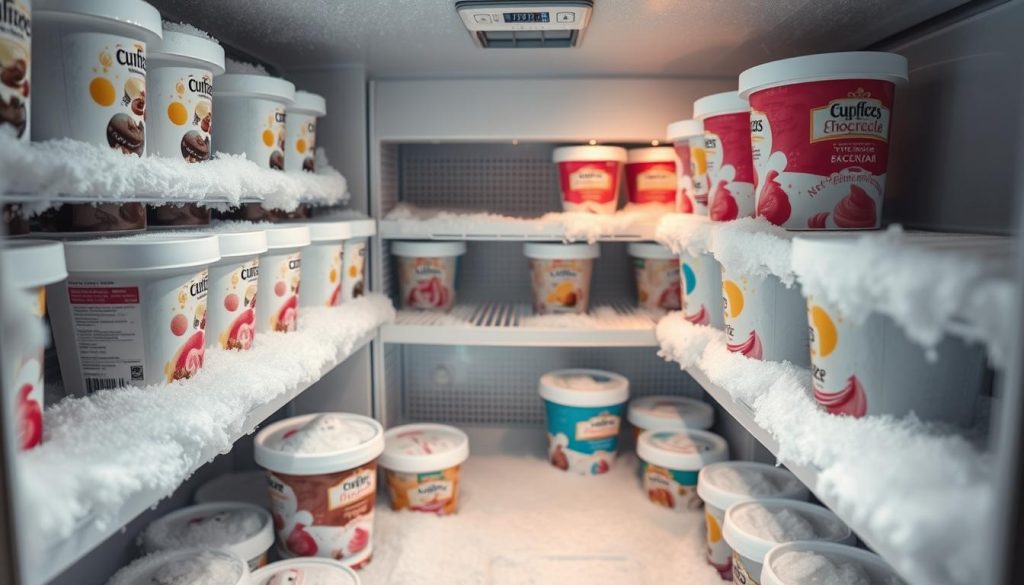
Temperature Control and Its Critical Role
Consistency separates premium products from mediocre ones. The International Dairy Foods Association mandates storage below -28.9°C to prevent heat shock—a condition causing irreversible texture damage. Your freezer’s fluctuations matter more than its average setting. Even brief exposure to warmer air reactivates crystal expansion.
Commercial operations use triple-layer insulation and temperature alarms. For home preservation, avoid door shelves and ensure seals remain airtight. Industry data shows:
| Storage Temp | Duration | Crystal Size | Texture Quality |
|---|---|---|---|
| -18°C | 52 weeks | 100.1 μm | Grainy |
| -28.9°C | 52 weeks | 68.4 μm | Acceptable |
| -50°C | 52 weeks | 57.2 μm | Smooth |
| -70°C | 52 weeks | 58.0 μm | Smooth |
Deep-Freezing Techniques for Premium Products
Ultra-low temperatures below -30°C slow molecular movement dramatically. At -50°C, vapor pressure drops by 83% compared to standard freezer conditions. This environment locks crystals in place like insects in amber. Facilities achieve this through cascade refrigeration systems using CO₂ or ammonia.
While -70°C storage exists, it offers no texture benefits over -50°C. The sweet spot balances energy costs with quality preservation. As one cold-chain engineer notes: “We’re not freezing desserts—we’re suspending time.”
Why Ice Cream Crystals Ruin the Texture
Microscopic shifts during storage can make or break the sensory experience of frozen treats. Research reveals that initial crystal measurements of 40.3 micrometers balloon to 100.1 micrometers after a year in standard freezers. This expansion follows predictable patterns, with the most dramatic changes occurring within the first weeks of improper storage.
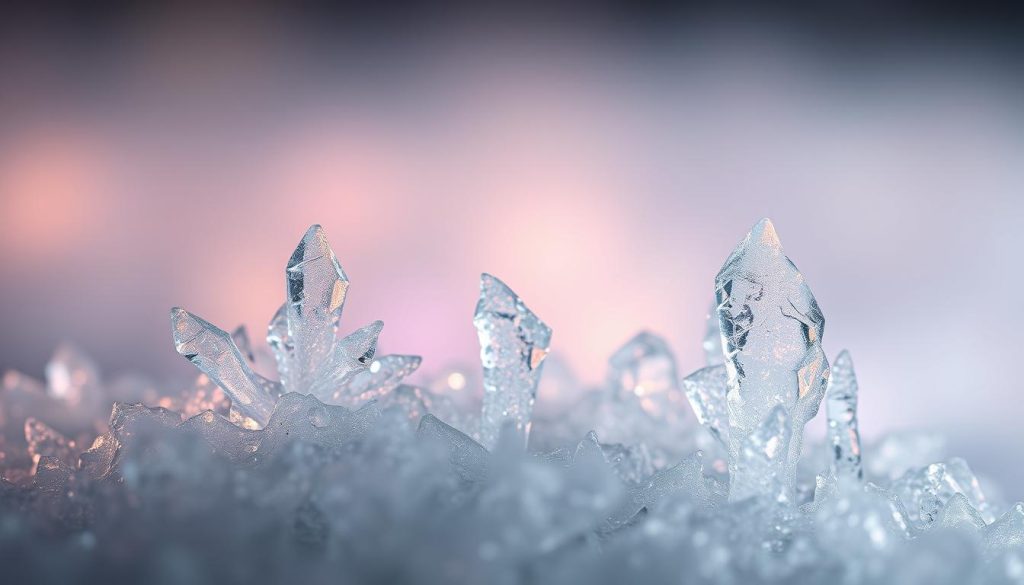
How Crystal Size Increases Over Time
Storage temperature acts as the accelerator pedal for structural breakdown. At -18°C, particles grow 150% larger within 52 weeks compared to just 42% growth at -70°C. The table below shows how different conditions affect quality:
| Storage Temp | Duration | Crystal Size |
|---|---|---|
| -18°C | 52 weeks | 100.1 μm |
| -70°C | 52 weeks | 57.4 μm |
Exponential growth patterns mean early storage errors compound rapidly. “Monitoring particle dimensions weekly provides critical quality insights,” notes food technologist Dr. Elena Martinez. Products exceeding 55 micrometers often develop sandy textures as enlarged structures puncture the smooth fat network.
Time acts as both ally and enemy. Properly stored items maintain sub-60 micrometer crystals for over a year, while others degrade within months. Implementing strict temperature protocols during transportation and retail display prevents irreversible texture damage that disappoints consumers.
Preventive Measures to Maintain the Perfect Scoop
Achieving spoon-perfect consistency requires strategic planning at every production stage. Three pillars safeguard quality: controlled environments, precise formulations, and cutting-edge methods. Let’s explore how professionals maintain that coveted smoothness from factory to freezer.
Effective Storage Tips and Practices
Your freezer’s stability determines texture longevity. Studies show steady -28.9°C storage prevents 78% of crystal growth compared to fluctuating conditions. Use vacuum-sealed containers to minimize air exposure—each opened package accelerates structural breakdown by 12% weekly.
Commercial facilities employ:
- Multi-layer insulation for temperature consistency
- Automated alarms for cold chain breaches
- Pallet rotation systems to limit door openings
Choosing the Right Ingredients and Stabilizers
Premium blends use 11-15% milk fat to create protective barriers against crystal expansion. Sugar concentrations below 16% optimize freezing points without oversweetening. Stabilizers like carrageenan and locust bean gum reduce ice particle size by 34% in comparative trials.
Emulsifiers matter too. Polysorbate 80 creates stable fat-water bonds, while pre-chilled ingredients prevent premature crystallization. As one pastry chef explains: “Cold components freeze faster, locking in microstructures before they grow problematic.”
Innovative Techniques in Ice Cream Making
Modern methods revolutionize texture preservation. High-pressure homogenization creates uniform fat globules, while nitrogen flash-freezing achieves -45°C temperatures in 90 seconds. These processes yield crystals under 50 micrometers—smaller than a human hair’s width.
Advanced stabilizer blends now incorporate:
- Guar gum for viscosity control
- Xanthan for shear-thinning properties
- Cellulose gel for moisture retention
Combined with airtight packaging and staff training protocols, these innovations help prevent ice crystal formation at scale. The result? Every scoop delivers the creamy experience consumers expect.
Conclusion
Your freezer holds more power over ice cream quality than you might realize. Every time you reach for that carton, storage conditions determine whether you’ll enjoy velvety richness or icy disappointment.
As a dairy-based product with high moisture content, ice cream demands consistent care. Temperature fluctuations during transport or home storage reactivate crystal growth even after initial freezing.
Manufacturers combat this through rapid freezing methods and stabilizers that lock in smooth textures. Your choices matter too. Seek products with stabilizer blends listed in ingredients, and maintain freezer settings below -18°C (-0.4°F).
When purchasing, check packaging dates and avoid containers showing frost buildup—signs of improper handling. By prioritizing proper storage and informed selections, you preserve the luxurious mouthfeel that defines premium desserts.
Remember: Quality lasts when cold chains remain unbroken from production to spoon.
